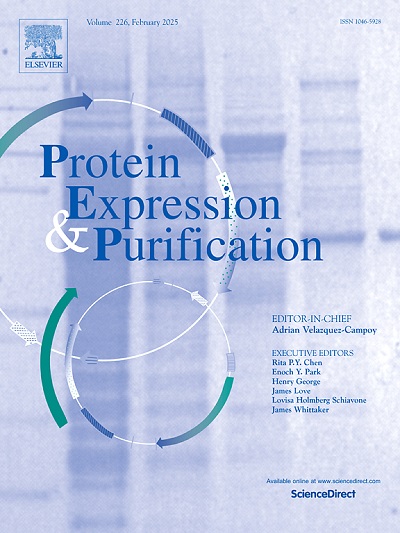Detection and optimization of microbial expression systems for extracellular production and purification of Ca2+-responsive phase-changing annexin fusions
IF 1.4
4区 生物学
Q4 BIOCHEMICAL RESEARCH METHODS
引用次数: 0
Abstract
Previously, we identified the human annexin A1 as a purification tag for column-free purification with gentler calcium-responsive precipitation. In this work, we used the annexin A1 tagged green fluorescent protein constructs for detecting extracellular production in Escherichia coli, Bacillus subtilis, and Pichia pastoris, and identified that the leaderless fusion protein was transported extracellularly in E. coli with supply of additives including Triton X-100. The coexpressed enzymes, culture compositions, and induction conditions in E. coli extracellular expression systems were optimized. With coexpression of phospholipase C from Bacillus cereus and addition of 0.2 % Triton X-100 after induction for 60 h at 28 °C, the annexin A1 tagged green fluorescent protein and 5-aminolevulinate dehydratase from E. coli were overexpressed and purified from lysogeny broth by precipitation with 20 mM Ca2+ and redissolution with 25 mM EDTA with the acceptable protein purities and recoveries. The silica binding peptide was fused to the annexin A1 tagged fluorescent protein fusion for successive affinity precipitation and purification. With incubation of the specific protease, the released tag-free protein displayed higher purity via on-resin cleavage than that through cleavage of the free fusion protein. The tandem tag is applicable for two-step purification of small or large amounts of other fusion proteins in the culture and recovery of tag-free proteins at low cost.
检测和优化用于细胞外生产和纯化 Ca2+ 反应相变附件蛋白融合体的微生物表达系统。
在此之前,我们发现人类附件素 A1 是一种纯化标签,可通过更温和的钙响应沉淀进行无柱纯化。在这项工作中,我们利用附件蛋白 A1 标记的绿色荧光蛋白构建体检测了大肠杆菌、枯草芽孢杆菌和 Pichia pastoris 的胞外产物,发现无领导融合蛋白在大肠杆菌中通过 Triton X-100 等添加剂进行胞外转运。对大肠杆菌胞外表达系统中的共表达酶、培养成分和诱导条件进行了优化。在 28 ℃ 诱导 60 小时后,加入 0.2% Triton X-100,与蜡样芽孢杆菌的磷脂酶 C 共表达,大肠杆菌的附件蛋白 A1 标记绿色荧光蛋白和 5-氨基乙酰脱水酶被过量表达,并通过 20 mM Ca2+ 沉淀和 25 mM EDTA 再溶解从溶菌酶肉汤中纯化,蛋白质纯度和回收率均可接受。硅胶结合肽与附件蛋白 A1 标记的荧光蛋白融合,进行连续的亲和沉淀和纯化。在特异性蛋白酶的作用下,通过树脂裂解释放的无标签蛋白的纯度高于裂解游离融合蛋白的纯度。串联标签适用于培养物中少量或大量其他融合蛋白的两步纯化,并能以低成本回收不含标签的蛋白。
本文章由计算机程序翻译,如有差异,请以英文原文为准。
求助全文
约1分钟内获得全文
求助全文
来源期刊

Protein expression and purification
生物-生化研究方法
CiteScore
3.70
自引率
6.20%
发文量
120
审稿时长
32 days
期刊介绍:
Protein Expression and Purification is an international journal providing a forum for the dissemination of new information on protein expression, extraction, purification, characterization, and/or applications using conventional biochemical and/or modern molecular biological approaches and methods, which are of broad interest to the field. The journal does not typically publish repetitive examples of protein expression and purification involving standard, well-established, methods. However, exceptions might include studies on important and/or difficult to express and/or purify proteins and/or studies that include extensive protein characterization, which provide new, previously unpublished information.
 求助内容:
求助内容: 应助结果提醒方式:
应助结果提醒方式:


